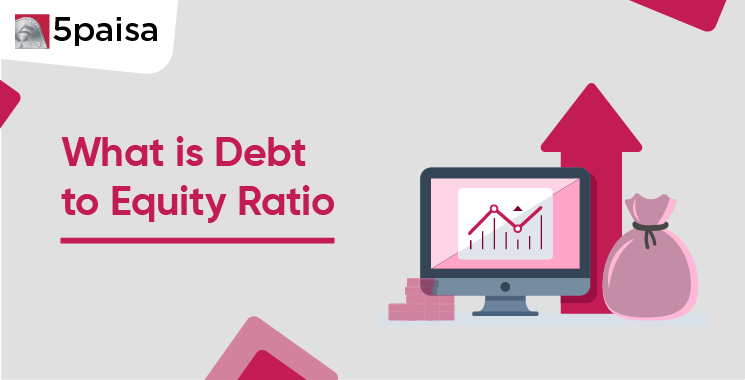Content
For any investor or business owner, understanding financial ratios is important for making informed decisions. One of the most important financial metrics is the Debt-to-Equity Ratio (D/E Ratio). It measures a company’s financial leverage by comparing its total debt to shareholders' equity.
In simple terms, the debt-to-equity ratio shows how much debt a company has for every rupee of equity. A higher ratio means more debt, while a lower ratio indicates a financially stable company with lower reliance on borrowed funds.
This guide explains what the debt-to-equity ratio is, how it is calculated, its importance, ideal levels, and its impact on investments. Whether you are a stock market investor, business owner, or finance enthusiast, this article will help you understand how this ratio affects a company’s financial health.
Unlock the full article - sign in with Gmail!
Expand Your Market Knowledge with 5paisa Articles
What is Debt-to-Equity Ratio?
The Debt-to-Equity (D/E) Ratio is a financial ratio that shows how much a company relies on debt compared to its own equity. It helps investors and lenders assess a company’s risk level.
Formula for Debt-to-Equity Ratio
Debt-to-Equity Ratio = Total Debt / Shareholders' Equity
Where:
- Total Liabilities (Debt) = Long-term and short-term debts of the company.
- Shareholders' Equity = The company's total assets minus total liabilities.
Example of Debt-to-Equity Ratio Calculation
Suppose ABC Ltd. has:
- Total Debt: ₹50 crore
- Total Shareholders' Equity: ₹100 crore
Then,
D/ERatio= ₹100crore/₹50crore = 0.5
This means ABC Ltd. has ₹0.50 of debt for every ₹1 of equity.
Why is Debt-to-Equity Ratio Important?
The D/E ratio is crucial for businesses and investors because it helps in:
1. Evaluating Financial Stability
A company with a high D/E ratio relies more on borrowed funds, making it riskier. A lower ratio indicates a strong financial position with less debt burden.
2. Understanding Risk
A higher D/E ratio means higher financial risk, as the company must repay more debt. Investors prefer companies with a balanced ratio to avoid financial distress.
3. Assessing Creditworthiness
Banks and financial institutions analyze the D/E ratio before giving loans. A company with a high ratio may struggle to secure funding at favorable interest rates.
4. Comparing Companies
Investors use the D/E ratio to compare companies in the same industry. Capital-intensive industries like real estate and infrastructure typically have higher ratios than service-based companies.
What is an Ideal Debt-to-Equity Ratio?
The ideal D/E ratio varies by industry. However, general guidelines include:
- 0.5 to 1.5 – Considered safe for most industries.
- Above 2.0 – Indicates high debt, which may be risky.
- Below 0.5 – Suggests the company is too conservative and may not be leveraging growth opportunities.
Industry-wise D/E Ratio Benchmarks
| Industry |
Ideal D/E Ratio |
| IT & Software |
0.2 - 0.5 |
| Banking & Finance |
5.0 - 7.0 |
| Infrastructure & Real Estate |
2.0 - 3.5 |
| Manufacturing |
1.0 - 2.5 |
| FMCG |
0.3 - 1.0 |
Investors should compare D/E ratios within the same sector rather than across different industries.
High vs. Low Debt-to-Equity Ratio: Pros & Cons
| D/E Ratio |
Meaning |
Pros |
Cons |
| High (Above 2.0) |
Company relies heavily on debt |
Faster growth due to borrowed capital |
Higher risk of default |
| Moderate (0.5 - 1.5) |
Balanced use of debt and equity |
Healthy financial position, easier credit access |
None |
| Low (Below 0.5) |
More reliance on equity funding |
Low financial risk, stable company |
May miss growth opportunities |
How Debt-to-Equity Ratio Affects Stock Market Investments?
For stock market investors, the D/E ratio is a key metric when selecting stocks. Here’s how it affects investment decisions:
1. High D/E Ratio Stocks – Risky but High Returns
- Companies with a high D/E ratio often borrow more to expand.
- These stocks may provide higher returns but are riskier during economic slowdowns.
Example: Infrastructure and capital-intensive companies like L&T or Adani Group.
2. Low D/E Ratio Stocks – Safe but Slow Growth
- Companies with a low D/E ratio rely less on borrowing, ensuring stable earnings.
- These stocks are less volatile, making them safe investments for conservative investors.
Example: IT and FMCG companies like Infosys or Hindustan Unilever.
Tip: Investors should balance their portfolio with both high and low D/E ratio stocks based on their risk appetite.
How Companies Can Improve the Debt-to-Equity Ratio?
Companies can improve their D/E ratio by:
- Reducing Debt: Paying off existing loans to lower financial burden.
- Increasing Equity: Issuing new shares or reinvesting profits.
- Managing Cash Flow Efficiently: Ensuring revenue covers expenses without excessive borrowing.
- Converting Debt to Equity: Restructuring loans by issuing shares.
A balanced D/E ratio attracts investors and improves business stability.
Debt-to-Equity Ratio vs. Other Financial Ratios
| Ratio |
Meaning |
Use Case |
| Debt-to-Equity Ratio |
Measures financial leverage |
Assess company’s debt burden |
| Current Ratio |
Measures liquidity |
Short-term financial health |
| Return on Equity (ROE) |
Measures profitability |
How efficiently equity is used |
| Interest Coverage Ratio |
Measures ability to pay interest |
If company can handle debt |
Investors should analyze multiple ratios along with the D/E ratio for a complete financial assessment.
Conclusion
The Debt-to-Equity Ratio (D/E Ratio) is a critical financial metric that helps investors assess a company’s financial health. While a moderate ratio indicates stability, a high ratio can signal financial risk.
For investors, understanding this ratio ensures better stock selection and risk management. Companies with a balanced D/E ratio attract more investors and gain easy access to credit.
Before investing, always compare the D/E ratio within the same industry, analyze other financial indicators, and assess the company’s long-term growth potential. A well-informed investment decision leads to better returns and lower risks.



